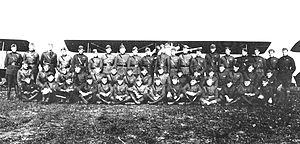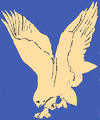4th Pursuit Group
| 4th Pursuit Group | |
|---|---|

141st Aero Squadron, November, 1918 Gengault Aerodrome (Toul), France
|
|
| Active | 1918-19 |
| Country |
|
| Branch |
|
| Type | Group |
| Role | Command and control |
| Part of | American Expeditionary Forces (AEF) |
| Engagements |
World War I |
| Insignia | |
| 17th Aero Squadron Emblem |  |
| 25th Aero Squadron Emblem |  |
| 141st Aero Squadron Emblem |  |
| 148th Aero Squadron Emblem |  |
The 4th Pursuit Group was an Air Service, United States Army unit that fought on the Western Front during World War I as part of the Air Service, Second United States Army. It was demobilized in France on 15 April 1919. There is no modern United States Air Force unit that shares its lineage and history.
The group was organized on 26 October 1918 at Gengault Aerodrome (Toul), France. On 27 October the 141st and 25th Aero Squadrons (Pursuit) were assigned to the unit. Both were new units, recently deployed to France and equipped with SPAD XIIIs. The Sixth Air Park was assigned to the Group on 30 October, it was equipped with trucks, cars, motorcycles and side-cars for the use of the Group.
The sector to be patrolled by the 4th PG was bounded on the west by Manheulles and Meilly-sur-Rouvres, and on the east by Custines, Landremont and Clémery. Operations began on 28 October when Captain Hobie Baker, 141st Squadron, engaged six enemy Fokkers near Prény and shot down one of them. Ten more enemy aircraft attacked the patrol from a higher altitude and the squadron managed to return to Allied lines without loss. Given the limited number of aircraft and pilots assigned to the Group, as many combat patrols as possible were flown each day.
On 4 November, the 17th and 148th Aero Squadrons were assigned to the Group, which brought the unit up to full strength. These two squadrons had previously been assigned to the British Royal Flying Corps and had been transferred to the Second Army and equipped with new SPAD XIII aircraft. On 5 November, a patrol of the 141st Squadron destroyed an enemy Halberstadt D.II aircraft near Hagéville. The enemy aircraft was returning from an aerial leaflet drop when attacked. Several days of bad weather kept the group grounded until the armistice on 11 November, after which no aircraft was permitted to cross into enemy territory.
...
Wikipedia
